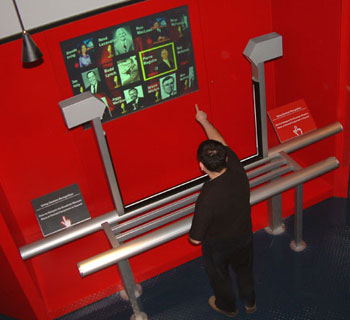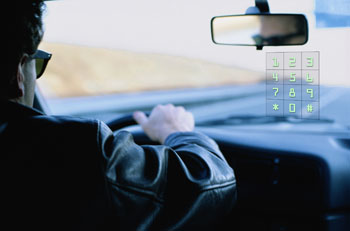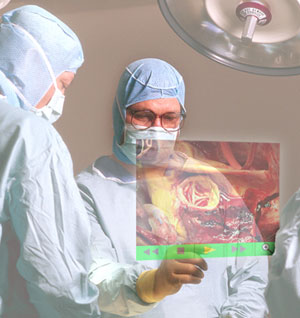Article
Reach out and touch ... nothing?
New advances in interface design - many of which seem to have arrived straight out of a sci-fi movie - might prove themselves more valuable than the venerable keyboard, mouse and touchscreen. Or will they?
April 11, 2005 by James Bickers — Editor, Networld Alliance
In Michael Crichton's novel Disclosure, a character inside a vault uses a keyboard to access some vital data. But the keyboard isn't a traditional one mounted on a dais or on the wall - it's a holographic projection, suspended in mid-air before him. He "types" on the floating, phantom keys, and when he is done, the projection is removed.
If you want to guess what human-machine interfaces might look like a century from now, science fiction is a great place to mine for ideas. Of course, there's that spectacular scene early in the film Minority Report, when Tom Cruise's character interacts with a wall-sized "touchless interface" as he hurriedly resizes and drags windows, opens files and digs through data to try to solve a future crime.
For some companies, though, the future looks a lot closer. Engineers and visionaries are hard at work on bringing these futuristic interfaces not only into the present, but also into a place where they are affordable enough to make sense in real-world applications.
Vincent John Vincent said his company GestureTek Inc. was "once way ahead of what the public could perceive." Formerly JesterTek Inc. and Vivid Group, GestureTek holds a patent on its Video Gesture Control technology. VGC powers a number of different products, from interactive signage to a turnkey gesture-driven mouse controller for use in public computers and kiosks. Vincent, the company's president, said that it is exactly because of films like Minority Report that the public is not only becoming comfortable with the idea of a touchless interface, it's starting to get excited about it.
 |
Visitors interact with the GestureTek interface at the Hockey Hall of Fame. |
"We are starting to see kiosk consultants and designers wanting to push the edge of kiosks in this direction," he said. "The magic and simplicity of gesturing at large-screen kiosks from an appropriate distance makes sense to the public that knows they have to step back far enough from a large screen to take it all in."
Wither the humble keyboard?
Before we stray too far into the future, let's pause to discuss the here-and-now; after all "magic and simplicity" were used not too long ago to describe the GUI in general, the mouse in particular. Is the mouse/keyboard combination truly "broken" enough to need fixing?
"Both devices have a learning curve," said Meryl Enerson, president of Enervision Media, an East Chatman, N.Y.-based consultancy that has helped companies like AT&T, Citibank and UPS design and deploy interactive content. "Of the two, the keyboard is steeper and longer. And unless you take the time to learn to touch-type, a QWERTY keyboard is always going to seem awkward because the letters are placed for efficiency, not in any perceived order relative to the alphabet."
Enerson also pointed out that the mouse/keyboard combo has long been the bane of those individuals with either accessibility or handedness issues - for instance, a kiosk with a trackball on the right hand side of the keyboard does a left-handed person no good.
"Many people have a hard time using a mouse for fine coordination, such as hitting small text links," she added. She noted that graphic artists often give up the mouse entirely, switching instead to a tablet-pen solution.
But having said all that, she points out that the keyboard/mouse paradigm has more than its share of strengths. "One strength is simply that the combination is now the standard for a very large installed base of computers, which means people are used to it," she said. "That doesn't mean people won't adapt to something new, but it may be a long time before the installed base changes over."
She also said that the redundancy of abilities - for instance, a user can opt to access a menu by mouse or keyboard, whichever they prefer - makes the pair of tools particularly useful, because people can customize the experience so that it is most efficient for their working style. And although the QWERTY keyboard might make no sense to a hunt-and-peck typist, it is that way for a reason: the placement of letters is optimized for efficiency.
 |
One possible use for touchless interfaces put forth by HoloTouch - a cell phone interface that goes wherever you want it to. |
Reach out, touch fate
Although people seem to have gotten pretty comfortable with the keyboard and mouse - and are increasingly making them work the way they want them to, adding options like wireless control and ergonomic designs of all varieties - they might be willing to try something new once they see the "wow factor" that is in store for them.
In 2004, Control Engineering magazine awarded its "most innovative interface" award to HoloTouch Inc. for its "BeamOne" interface. BeamOne utilizes a combination of holographic imaging and wave source sensors to hover a simulation of a computer's keyboard or on-screen interface in front of the screen. The user "touches" these patches of air, and infrared sensors detect movement within the hotspots and pass the information along to the machine. As far as the computer knows, it could have just as easily received the data from a traditional keyboard.
HoloTouch president Doug McPheters said that his company's product has a number of strong facets going for it: there are no moving parts for the customer to misuse, the touchless model removes any hygiene concerns, and holographic images are impervious to dirt, moisture, shock, and the elements, making them ideal for outdoor and high-traffic areas.
Plus, this whole idea carries some major buzz Â… simply put, it is cool. Once they start becoming prevalent in the retail space, for instance, touchless interfaces will likely stop foot traffic for years to come - you can almost hear the "oohs" and "aahs" now, can't you?
"I think pointing to things is very intuitive and doesn't take much adaptation," Enerson said. "A well-designed touchscreen kiosk using such an interface would probably go over well today. Cost of equipment and the appropriateness for the environment for use, however, is what will drive the adoption in the home and business markets."
Both Vincent and McPheters agree that a key aspect of the touchless interface is its appropriateness for each given application. After all, this does represent a giant leap away from the "one interface to rule them all" mindset that has been the norm for years since the widespread adoption of the keyboard/mouse combo as the default configuration.
"There is no perfect type of interface," Vincent said. "Designs that are intuitive and match the type of interaction are always best, instead of the concept of having the same type of interface for all types of interactions."
"Until the advent of thought control, we're unlikely to achieve a perfect generic interface," McPheters said. "As in the case of the so-called `universal' TV/DVD/VCR remote, a perfect generic interface to many types of electronics may remain illusory until then."
Specific applications
So what kinds of applications are well-suited to such a futuristic interface?
Vincent said that GestureTek has had great success in science centers and museums, in corporate promotions, and in retail. The company's first product involved a green screen backdrop, allowing users to put their moving images inside the application's virtual world; they could then interact with items within that world using body gestures.
On a more portable note, there is GestPoint technology, which allows users to simply point at a screen - any screen - and interact with it. Vincent said this has been successful in retail - more than 300 installations involve displays inside store windows which passersby can manipulate by pointing through the window.
"No matter what the configuration, no one ever has to wear, hold or touch anything, since the camera captures their gestures from a distance," he said. "There is no wear and tear over time of use, and nothing ever gets broken by user overuse or misuse. This is an invaluable feature." GestureTek announced earlier this year that they were licensing their technology to Sony, for use in EyeToy and PlayStation2 entertainment products.
 |
A HoloTouch application at work in the operating room - where the touchless interface removes concerns about sterility and cleanliness raised by traditional interfaces. |
McPheters said HoloTouch has had great success in medical environments like operating rooms. Typically, a doctor performing a surgery has to instruct an assistant to interact with touchscreens and keypads, for reasons of cleanliness. With a virtual keyboard projected in mid-air over the patient, the doctor can control these crucial devices with their own hands - and because it is simply light that is being manipulated, the holographic images do not affect the sterility of the room. Since the projections can be stretched out across long distances, multiple devices can project their interface into the doctor's workspace, rapidly improving efficiency.
Other healthcare applications can involve the patient: For instance, outpatient kiosks can speed the check-out process, but cleanliness and hygiene become concerns. Virtual interfaces eliminate the possibility that patients could swap infections or diseases simply by using the same keyboard or touchscreen.
Looking down the road
Just because a technology works, has merit and is needed doesn't necessarily mean it will succeed - the idea graveyard, after all, is filled with some brilliant ones. Enerson said that designers of touchless interfaces will have to remember some basic things about human nature in order to keep their innovations out of that graveyard.
"Hardware still scares some people, and the more computer-like it is, the more it scares them," she said. "I think hardware interfaces should strive to be invisible - only when the user doesn't realize that he or she is using a computer does a well-designed hardware interface really succeed.
"The next five years are going to be very interesting," she added. "As computing technology gets cheaper and designers get more innovative, computers are going to be everywhere. It'll be interesting to see which of the current innovations are imitated the most - because that will most likely shape the face of interface design in 2010."










